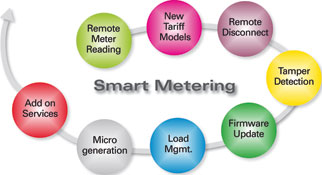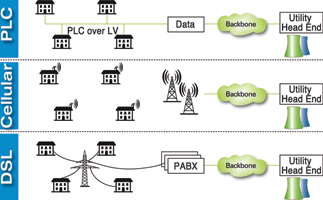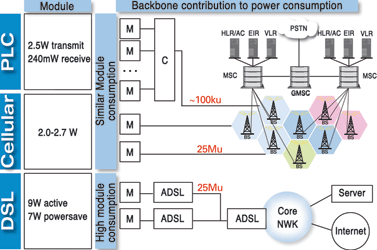
The European Union is committed to achieving aggressive environmental targets through its ‘20-20-20’ project. The goal is to achieve a 20% reduction in greenhouse gas emissions by the year 2020, compared to 1990 levels, with at least 20% coming from renewable sources.
The region has the added motivation to be less dependent on less stable sources of energy from outside the EU. Considering that the average home generates around 5,5 tonnes of CO2 per year, and that there are more than 200 million homes in the European Union, one can see that one of the key factors will be to reduce energy consumption in the home.
The EU is adopting a multi-tiered strategy, not only to improve energy efficiency of appliances in the home, but also to increase consumer awareness and their ability to influence how energy is managed within their home. This has led to the concept of ‘in home energy monitors’, which provide consumers with the ability to not only monitor energy consumption within the home, but also to analyse which appliances are connected to the in-home electricity supply and to take automated intelligent decisions on their use.
To facilitate such automation, an in-home local area communications network (LAN) is needed. Furthermore, to enable comprehensive management of the complete energy supply grid, communication is also needed on a wider scale so that energy demand and consumption can be managed across the whole grid, from the energy generator all the way to the consumer, thus giving way to the concept of smart grids.
Learning from experience
Although this article concentrates on the European market, the topics it covers are no less pertinent to us in South Africa, albeit that the technologies it discusses may take more time to reach critical mass here.
This article focuses on the technology selection for the connection of the home to the grid, often called the ‘last mile’ or wide area communications network (WAN). As more vendors of communications technology become aware of the business opportunities presented by smart metering and smart grids, there is increasing confusion about the technologies that can facilitate them.
Finding the way through the technology maze can be a daunting prospect. So which technology (or technologies) should be chosen as a base technology for a smart grid WAN communications network? Well a good starting point would be to look at established WANs.
It is a fact that more than 90% of the established or planned automatic meter reading (AMR), automatic meter management (AMM) and smart grids projects in Europe have selected power line communication (PLC) as the WAN technology of choice. Consider that the large Italian electricity utility company Enel has already installed a network of more than 30 million PLC enabled meters.
Also, the leading utilities in Spain and France, collectively covering more than 50 million meter points, have clearly stated their intention to use PLC in their networks. There are also many smaller installations that would increase the total of established/planned PLC enabled meters to more than 100 million.
Coming a distant second place is cellular technology (eg, GSM/GPRS) which tends to be used in less densely populated areas, or in those areas where large scale rollout is not part of the plan. DSL is being considered as a possible future solution, for example in the UK, where there is a government backed plan to achieve 100% DSL penetration by 2012. However, DSL is not commonly used as a WAN technology today.
To examine which is the best technology for the task, this article will consider aspects such as application requirement, data requirements, cost comparison, energy efficiency, network availability and security.
Application requirements
A typical set of smart grid applications is shown in Figure 1. Today’s requirements cover applications such as remote meter reading, remote tariff updates, remote disconnect and tamper detection, whilst the ability to make remote firmware updates gives confidence that the life of meter assets can be extended in the future. Once the smart grid is in place the next step is to use it to allow demand side (load) management. Actually, that is one of the most important topics for achieving energy efficiencies.

Looking to the future, micro-generation needs to be supported, and there will be the need to manage communications with electric vehicles (for charging the car as well as for charging the vehicle owner). It is possible to envisage additional services that could be offered, such as remote monitoring of properties for intrusion, remote healthcare and others.
Of course it is obvious to say that a technology selection needs to fit today’s requirements, but it is also important to select a technology that is scalable for the future, and interoperable with existing technology so that legacy systems can be supported.
There is a real danger here, however, that uncertainties about undetermined future needs can lead some to discard available and proven technologies with the argument that “if it is already available then it cannot meet my future needs, can it?” Instead, some are looking to unproven technology that promises to be ‘future-proof’ but where the proof is also in the future.
Network topologies
It is also helpful to understand the different topologies that would apply to the different technologies (see Figure 2), especially when evaluating comparative system costs, power consumption, or how reliable access to the network would be.

In the case of PLC the local powerline network is connected to a concentrator or data collector in the local substation. This is an important point – the data is concentrated at this point which makes for very efficient communications over the backbone, this being the network which connects the last mile to the back-office ERP systems.
Typically a single access to the concentrator in the substation allows the exchange of relevant data from up to a few thousand meters at once. It is also possible in PLC networks to send broadcast messages that are sent to all meters, so all meters in a network can be updated with a single message. This could be for example a tariff update or a firmware upgrade.
In cellular networks there would be a local transmitter mast as an intermediate step for the communications, but it would not concentrate data – it would be a point-to-point connection and a point-to-point communication is required for every single data exchange.
One can see that this will not make for efficient network communications, either from a data capacity point of view or from an energy efficiency point of view, because energy is consumed when each communication is happening. Again, in the DSL case, there would be a local switch, but effectively the communications is point-to-point and thus inefficient.
Market structure
In some regions such as the UK or the Netherlands, there is a complex market structure with no single entity owning the complete vertical chain from generation to retail. As a result, there are different generators, distribution companies, retailers, meter owners, meter operators and so on. Even though some companies have stakes in different parts of the chain, these still have to be completely separate business entities.
Also in the PLC context the market adds complexity because the last mile is owned and controlled by independent companies such as distribution network operators (DNOs) that do not have a need to receive meter data. So, in order for PLC to be used in these areas there would need to be adjustments to the market structure, either by forcing DNOs to open the last mile and meter asset providers (MAPs) to install smart meters, or to add communications modules.
However, the implementation of any technology would require adjustment of the market model, and in the case of cellular and DSL there would be a need for a new entity to manage the communications network and it would need commercial relationships with the existing market players etc. So the key arguments used against PLC related to market model are no more valid than they are for any other technology.
Network data requirements
The data requirements that were estimated in the 2007 UK Energy Retail Association (ERA) Smart Metering Operating Framework estimated, for example, that 100% of meters will be read once per day, whilst 25% of meters could have a new tariff set once per month.
If we take this one step further by assuming a network size of 500 meters per concentrator, we can conclude for electricity meters, that a net data rate of (just) 35 bits per second would be required across the WAN communications network. We say ‘net’ because in any communications network there will be an overhead of the packaging that goes around the actual data to ensure the data gets to its intended destination.
Typically this overhead could be an additional 25%. For gas meters the data requirement is much lower – just 3 bits per second – resulting in a total requirement based on known services today of 38 bits per second. It is worth noting that this data is only illustrative and it is widely believed that higher data rates will be required in the future.
However, PLC technology already delivers more than 10 times the net data rate required, with a roadmap for much higher data rates. So the conclusion is that PLC perfectly fits the data requirements of today’s and tomorrow’s applications. Cellular solutions would also fit quite well in terms of data capacity, whilst DSL solutions are over-sized and over-specified.
Cost of ownership
To understand the real cost of the technology selection it is necessary not only to consider the initial cost of the communications modem, but also to consider the cost of ownership. This mainly comprises the data costs, which are free for energy providers who own the last mile network, but not for DSL/cellular services where data needs to be paid for.
The initial costs for PLC and cellular are fairly similar, whilst the cost of ownership is dramatically higher in the case of cellular. It is these running costs that really make the financial difference. If we multiply this data out over a 15 year lifetime of a meter then we can see the significant differences in cost of ownership over a meter’s lifetime.
If we multiply this out over 25 million meters then we can see that PLC offers a significantly lower-cost solution than other technologies. And, there can also be hidden costs due to technology obsolescence, especially in the telecoms area where technology evolution is being driven by consumer demand.
Network energy efficiency
As mentioned earlier, it is important to know the architecture of the network when considering energy consumption (see Figure 3). If we think simplistically about the communications modem itself, then we see that PLC and cellular modules have similar consumption, whereas DSL requires far more power.

However, when we look at the backbone the situation becomes far more complex. The data concentrator plays an important role in PLC networks as it concentrates data and so communications between the concentrator and head end system are more infrequent.
On the other hand, every communication for a cellular or DSL system would be a point-to-point communication through the local mobile mast or PABX through the backbone to the back office. Furthermore, in a cellular system there is frequent communication between the network and the module, even when there is no data to transfer.
So we conclude that PLC is the most energy efficient solution, and considering that the main motivation for introducing smart metering is to achieve energy efficiencies, it would seem strange to select more power hungry technologies.
Network availability and security
A key issue for energy providers will be to make sure that connection with the network is reliable. Broken connections can mean the inability to bill customers and can lead to the need to send engineers to site to repair problems, especially difficult where the consumer is intentionally interfering with the meter.
With a PLC network, interrupting the communication requires tampering with the power-line. It is possible of course to cut the line but most consumers would only do it once! And, without communications there is no power, so there is little motivation for a consumer to try this.
With cellular communications, the problems of network coverage are well known, especially in buildings. Considering that meters are often located under the stairs, in a metal cabinet, or in the cellar, it is likely that the problem for cellular reception would be even more critical here.
It is also simpler for consumers to intentionally interfere with RF communication, and they could do this without interruption to power. There are other concerns for cellular related to consistent network availability. And it is quite unlikely that the same cellular technology will be available in 15 years time as this technology evolution is driven by consumer demand in mobile phones.
In the DSL case it is likely that an additional, dedicated line would be required. Otherwise it would be too easy for a consumer to interfere with their broadband router. But even with a dedicated line it would be possible to cut the line or unplug the cable.
Taking all this into account it is clear that PLC is the only technology that offers a really reliable and secure network availability.
In terms of coverage, a PLC network will use meters as repeaters; this is a common network architecture in suburban areas. So it is perfectly possible to achieve coverage of an area as large as 30 km² from a single concentrator. Interestingly, in rural areas it is a commonly held view that powerline is not so suitable, although there have been examples where it has worked quite well because the line conditions are quite favourable due to less noise interference from industry or neighbouring properties. Also, in some remote areas, cellular connections are not always available.
DSL does not provide good coverage today, but if we believe the target of the Digital Britain initiative to achieve 100% connectivity by 2012, then it could provide a solution in the future for the UK, albeit with higher power consumption, cost and network reliability issues.
Smart grid features for free
Finally, a PLC network will offer additional benefits that are not possible with other technologies because of the existence of a PLC concentrator in the local substation. An example is load control: the concentrator can analyse which phase meters are connected to, by means of zero crossing detection and the use of logical network IDs, then the network operator can judge which phase to connect new buildings to.
Furthermore, network problems can be identified and located at an early stage and repairs can be scheduled appropriately, even before power has failed in some networks. Even if there is no redundancy in the power grid (if the right hand substation in Figure 4 did not exist), it would still be possible to identify where the fault is, although of course in that case power would have failed and repairs would need to be carried out urgently.

For more information contact Marinus Rudman, Hi-Q Electronics, +27 (0)21 595 1307, [email protected], www.hi-q.co.za
| Tel: | +27 21 595 1307 |
| Email: | [email protected] |
| www: | www.hi-q.co.za |
| Articles: | More information and articles about Hi-Q Electronics |

© Technews Publishing (Pty) Ltd | All Rights Reserved